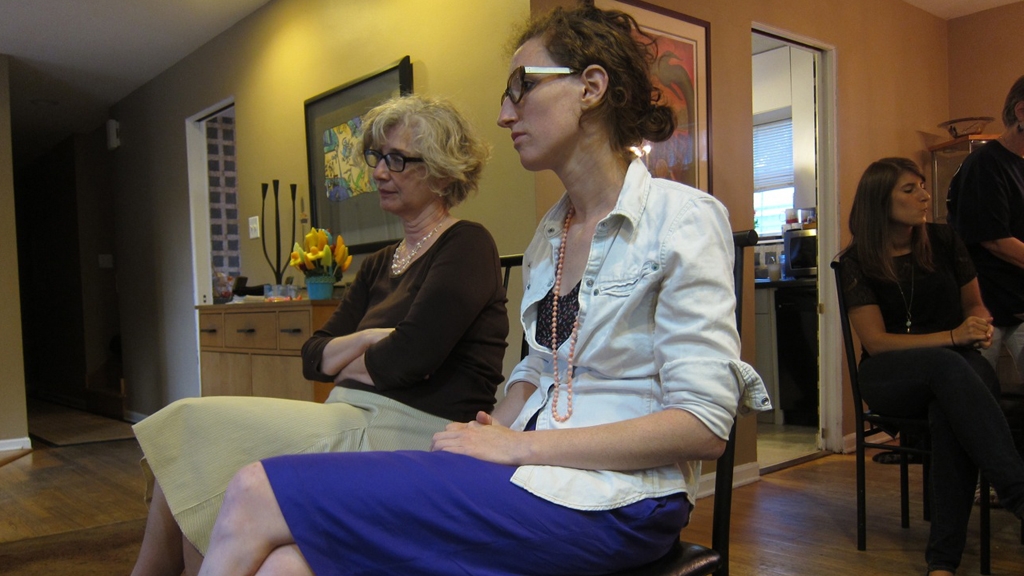We are not alone. This is the fundamental message of Judaism about death and bereavement. Every law and every custom of Jewish mourning and comforting has, at its core, the overwhelming motivation to surround those who are dying and those who will grieve with a supportive community. While some may argue that facing death and coping with grief heighten one’s feeling of aloneness, the Jewish approach places loss and grief in the communal context of family and friends.
READ: How To Be the World’s Best Shiva Guest
Comforters are obligated to tend to the needs of mourners. For instance, since a family sitting [seven days of mourning following a death] should not prepare meals, it is the responsibility of the community to feed them. Some people send prepared foods from local caterers, and many Jewish newspapers carry ads for “shiva trays.” With our busy, frenetic lives, it is certainly convenient to turn to these sources. Yet personally prepared and/or delivered food is a more traditional act of comfort. Liquor, candy, or flowers are not usually sent. A donation to a charity designated by the mourners would be another appropriate way to honor the deceased, while comforting those who mourn.
As a comforter, making a shiva call is one of the most important acts of condolence. But all too often those visiting a mourner’s home are not sure of the appropriate behavior. David Techner, funeral director at the Ira Kaufman Chapel in Detroit and a leading expert in the field, suggests that many people do not have the slightest idea as to why they even make the shiva call. “People need to ask themselves: ‘What am I trying to do?’ When people say things like, ‘At least he’s not suffering,’ who are they trying to make comfortable? Certainly not the mourner. People say things like that so that they do not have to deal with the mourner’s grief. The comment is for themselves, not the mourner.”

Help us keep Jewish knowledge accessible to millions of people around the world.
Your donation to My Jewish Learning fuels endless journeys of Jewish discovery. With your help, My Jewish Learning can continue to provide nonstop opportunities for learning, connection and growth.
In my interviews with rabbis, funeral directors, psychologists, and lay people for my book, A Time to Mourn, A Time to Comfort, I discovered that the act of comforting the mourner is quickly becoming a lost art. We do not know what to do, so many people avoid making a shiva call altogether. We do not know what to say, so many people say things that are more hurtful than helpful. We do not know how to act, so often the atmosphere is more festive than reflective.
The problem is exacerbated by mourners and their families who do not know how to set an appropriate tone. Many observances have become like parties, with plenty of food, drink, and chitchat. Of course, there are alternatives. In some shiva homes, the minyan [prayer service with at least 10 Jews, where the mourner says Kaddish, the memorial prayer] becomes the focus. During the service [or just before and just after it], the life of the deceased is remembered through stories and anecdotes.
Practical Tips for Shiva Visits

Whichever type of shiva home you encounter, there are some basic guidelines for making a shiva call.
Decide when to visit. Listen for an announcement at the funeral service for the times that the mourners will be receiving guests. Usually the options are immediately after the funeral, around the im in the evenings and mornings, or during the day. Should you wish to visit during another time, you may want to call ahead. Some experienced shiva visitors choose to visit toward the end of the week, when it is frequently more difficult to gather a minyan.
Dress appropriately. Most people dress as if attending a synagogue service. Depending on the area of the country, more informal dress might be just as appropriate.
Wash your hands. If you are visiting immediately after the funeral, you will likely see a pitcher of water, basin, and towels near the door. It is traditional to ritually wash your hands upon returning from the cemetery. This reflects the belief that contact with the dead renders a person “impure.” There is no blessing to say for this act.
Just walk in. Do not ring the doorbell. The front door of most shiva homes will be left open or unlocked, since all are invited to comfort the mourners. This eliminates the need for the mourners to answer the door. On a practical level, it avoids the constant disruptive ringing of the bell.
Take food to the kitchen. If you are bringing food, take it to the kitchen. Usually there will be someone there to receive it. Identify the food as meat, dairy, or pareve [neither meat nor dairy]. Be sure to put your name on a card or on the container so that the mourners will know you made the gift. It also helps to mark any pots or pans with your name if you want to retrieve them later.
Find the mourners. Go to the mourners as soon as possible. What do you say? The tradition suggests being silent, allowing the mourner to open the conversation. Simply offering a hug, a kiss, a handshake, an arm around the shoulder speaks volumes. If you do want to open a conversation, start with a simple “I’m so sorry” or “I don’t know what to say. This must be really difficult for you” or “I was so sorry to hear about _______.” Be sure to name the deceased. Why? Because one of the most powerful ways to comfort mourners is to encourage them to remember the deceased.
Recall something personal: “I loved _______. Remember the times we went on vacation together? She adored you so much.” Do not tell people not to cry or that they will get over it. Crying is a normal part of the grieving process. And, as most people who have been bereaved will tell you, you never “get over” a loss, you only get used to it.
Spend anywhere from a few moments to 10 minutes with the mourners. There will be others who also want to speak with them, and you can always come back. If you are the only visitor, then, of course, spend as much time as you wish.
Participate in the service. If a prayer service is conducted during your call, participate to the extent you can. If you do not know the service, sit or stand respectfully while it is in progress. If the rabbi or leader asks for stories about the deceased, do not hesitate to share one, even if it is somewhat humorous. The entire purpose of shiva is to focus on the life of the person who has died and his or her relationship to the family and friends in that room.
If invited, eat. Take your cue from the mourners. In some homes, no food will be offered, nor should you expect to eat anything. In others, especially after the funeral, food may be offered. Be sure that the mourners have already eaten the meal of condolence before you approach the table. When attending a morning minyan, you will likely be invited to partake of a small breakfast. After evening minyan, coffee and cake may or may not be served. In any case, should you be invited to eat, be moderate in your consumption. Normally, guests are not expected to eat meals with the family during the shiva.
Talk to your friends. Inevitably, you will encounter other friends and acquaintances at a house of mourning. Your natural instinct will be to ask about them, to share the latest joke, to shmooze about sports or politics. You may be standing with a plate of food and a drink, and if you did not know better, it would feel like a party. But the purpose of the shiva is to comfort the mourners.
You are in the home to be a member of the communal minyan. The appropriate topic of conversation is the deceased. Reminisce about his or her relationship to the mourners and to you. Of course, human nature being what it is, we tend to fall into our normal modes of social communication. This is not necessarily bad; however, you should be careful to avoid raucous humor, tasteless jokes, loud talk, and gossip.
Do not stay too long. A shiva visit should be no more than an hour. If a service is held, come a few minutes before and stay a few after. Mourners uniformly report how exhausted they are by the shiva experience; do not overstay your welcome.
Say goodbye. When you are ready to leave, you may want to wish the bereaved good health and strength, long life, and other blessings. The formal farewell to a mourner is the same Hebrew phrase offered at the gravesite and in the synagogue on Friday evening: “May God comfort you among the other mourners of Zion and Jerusalem.”
Once again, the message is “we are not alone.” In fact, traditional Jewish practice requires a minyan of 10 in order to recite the prayer. Personal bereavement is thus seen in the total context of the community.Ha-Makom is a name of God that literally means “the place,” referring to God’s omnipresent nature, including at the lifecycles from birth to death. It is only God who can grant the mourner lasting comfort. The comforter comes to remind the mourners that the divine powers of the universe will enable them to heal and go on with a meaningful life. Ultimate consolation comes only from the omnipresent God.
The great genius of Jewish bereavement is to empower the community to be God’s partner in comforting those who mourn. In making a shiva call in an appropriate and traditional way, we are the medium through which God’s comfort can be invoked. In learning the art of coping with dying, we are, in fact, learning an important aspect of the art of Jewish living.
Reprinted with permission from Wrestling with the Angel: Jewish Insights on Death and Mourning, edited by Jack Riemer (published by Schocken Books).
To read this article, “How to Make a Shiva Call,” in Spanish (lee en Español), click here.
Sign up for a Journey Through Grief & Mourning: Whether you have lost a loved one recently or just want to learn the basics of Jewish mourning rituals, this 8-part email series will guide you through everything you need to know and help you feel supported and comforted at a difficult time.
Looking for a way to say Mourner’s Kaddish in a minyan? My Jewish Learning’s daily online minyan gives mourners and others an opportunity to say Kaddish in community and learn from leading rabbis.



